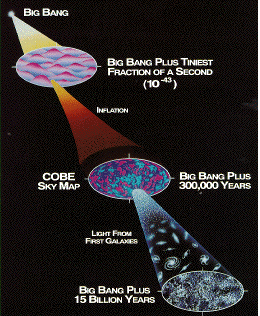One of the most persistently asked questions has been: How was the universe created? Many once believed that the universe had no beginning or end and was truly infinite. Through the inception of the Big Bang theory, however,no longer could the universe be considered infinite. The universe was forced to take on the properties of a finite phenomenon, possessing a history and a beginning.
About 15 billion years ago a tremendous explosion started the expansion of the universe. This explosion is known as the Big Bang. At the point of this event all of the matter and energy of space was contained at one point. What exisisted prior to this event is completely unknown and is a matter of pure speculation. This occurance was not a conventional explosion but rather an event filling all of space with all of the particles of the embryonic universe rushing away from each other. The Big Bang actually consisted of an explosion of space within itself unlike an explosion of a bomb were fragments are thrown outward. The galaxies were not all clumped together, but rather the Big Bang lay the foundations for the universe.
The origin of the Big Bang theory can be credited to Edwin Hubble. Hubble made the observation that the universe is continuously expanding. He discovered that a galaxys velocity is proportional to its distance. Galaxies that are twice as far from us move twice as fast. Another consequence is that the universe is expanding in every direction. This observation means that it has taken every galaxy the same amount of time to move from a common starting position to its current position. Just as the Big Bang provided for the foundation of the universe, Hubbles observations provided for the foundation of the Big Bang theory.
Since the Big Bang, the universe has been continuously expanding and, thus, there has been more and more distance between clusters of galaxies. This phenomenon of galaxies moving farther away from each other is known as the red shift. As light from distant galaxies approach earth there is an increase of space between earth and the galaxy, which leads to wavelengths being stretched.
In addition to the understanding of the velocity of galaxies emanating from a single point, there is further evidence for the Big Bang. In 1964, two astronomers, Arno Penzias and Robert Wilson, in an attempt to detect microwaves from outer space, inadvertently discovered a noise of extraterrestrial origin. The noise did not seem to emanate from one location but instead, it came from all directions at once. It became obvious that what they heard was radiation from the farthest reaches of the universe which had been left over from the Big Bang. This discovery of the radioactive aftermath of the initial explosion lent much credence to the Big Bang theory.
 Even more recently, NASAs COBE satellite was able to detect cosmic microwaves eminating from the outer reaches of the universe. These microwaves were remarkably uniform which illustrated the homogenity of the early stages of the universe. However, the satillite also discovered that as the universe began to cool and was still expanding, small fluctuations began to exist due to temperature differences. These flucuatuations verified prior calculations of the possible cooling and development of the universe just fractions of a second after its creation. These fluctuations in the universe provided a more detailed description of the first moments after the Big Bang. They also helped to tell the story of the formation of galaxies which will be discussed in the next chapter.
Even more recently, NASAs COBE satellite was able to detect cosmic microwaves eminating from the outer reaches of the universe. These microwaves were remarkably uniform which illustrated the homogenity of the early stages of the universe. However, the satillite also discovered that as the universe began to cool and was still expanding, small fluctuations began to exist due to temperature differences. These flucuatuations verified prior calculations of the possible cooling and development of the universe just fractions of a second after its creation. These fluctuations in the universe provided a more detailed description of the first moments after the Big Bang. They also helped to tell the story of the formation of galaxies which will be discussed in the next chapter.
The Big Bang theory provides a viable solution to one of the most pressing questions of all time. It is important to understand, however, that the theory itself is constantly being revised. As more observations are made and more research conducted, the Big Bang theory becomes more complete and our knowledge of the origins of the universe more substantial.
excerpt taken from http://www.umich.edu/~gs265/bigbang.htm

No comments:
Post a Comment